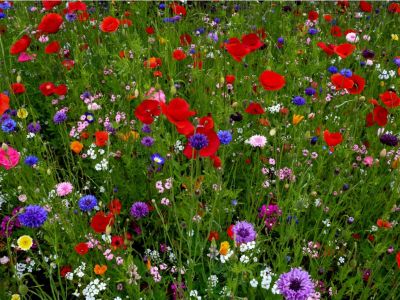Wildflower Gardening
Most wildflower and native gardens are planted in borders and beds, sometimes along tree or property lines. A quick scan of your property and surrounding landscape will enable you to see exactly what plants thrive in your area. These plants and others with similar attributes will be the ideal choices for your desired wildflower gardening planting scheme.
How to Use Wildflowers and Native Plants
Typically, you’ll find the most wildflower species growing within woodland environments, and these are often the more commonly planted. Woodland gardens are composed of native species that include a variety of flowering plants, grasses, shrubs, and trees. Designing your own native plant landscape often entails carefully layered plantings, as found in their natural setting. This could include a grouping of small trees followed by shrubs and finished off with foliage plantings, such as ferns, and other wildflowers. Many of these native plants thrive in partially shaded areas and can easily be incorporated into any shady areas of the yard that you may find challenging for growing other types of plants. In fact, placing shade-loving plants like anemone, bleeding heart, wild ginger, or hepatica beneath a large shade tree will create a lovely woodland garden for those with limited space. Meadows or prairies are another way to enjoy the benefits of a native plant landscape, especially for those with wide, open spaces. In a native meadow garden, wildflowers bloom abundantly throughout the season. Most meadows include both native grasses and wildflowers. Some of the more commonly grown plants here include:
Black-eyed Susan Butterfly weed Blazing star Joe-pye weed Aster Coneflower Blanket flower Daylily Daisy
Natural prairie gardens may consist of nothing more than open grassland but if you mix it up by adding wildflowers, the result will be a pleasing blend of vivid flower colors popping out from the greens and golds of native grasses. You can easily create either of these gardens by converting a treeless lawn into plantings of native grasses along with a variety of wildflowers, or whatever grows naturally in your area. Good choices to try may include:
Prairie dropseed Switchgrass Indian grass Prairie clover Goldenrod Bluebells Butterfly weed Prairie onion Prairie smoke
Growing wildflowers spread more naturally throughout the native plant landscape. They are also more trouble-free and easier to maintain than most other flower gardens. Whatever type of native garden you choose, mix in various heights, forms, colors, and textures. Choose wildflowers that bloom at different intervals as well as those with attractive foliage to ensure year-round interest. Regardless of when, where, or what you plant, the site preparation should include manageable soil, suitable light, and a nearby water source. Once your plants have established themselves in the garden, nature will take care of the rest, allowing you time to sit back and take it all in.
